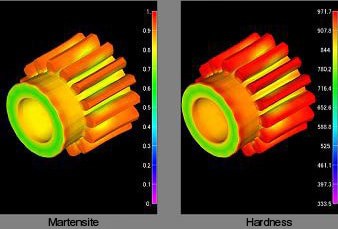News
Best heat treatment for gears?
Heat treating is a very key production step during the gear manufacturing process. This can represent up to 30% of the manufacturing costs.
By modifying the physical, chemical and metallurgical properties of the gear, heat treatment can optimize and even extend the life of the gear, making this process a critical one in gear manufacturing. Different methods of heat treatment can improve both surface and core hardness, boost machinability, enhance ductility and strength, minimize distortions, and reduce wear and tear.
Some heat treatment processes target the whole gear, while others may be directed at certain parts of the gear, such as the teeth. Hence, depending on the requirements of the specific gear application, different types of heat treatments may be utilized.
Heat Treatment Processes

There are several key heat treatment processes used in gear manufacturing today. Annealing and normalizing are processes used to soften the gear or part and relieve residual stress. Some of the more prevalent processes to harden the gear are through or direct hardening, case hardening —carburizing, carbonitriding, nitriding, nitrocarburizing, and applied energy hardening — flame, laser, induction.
Annealing refers to the process of heating the gear to a high, pre-determined temperature for an extended period and then slowly cooling it. This results in the recrystallization of the material, thereby improving machinability.
Normalizing is an annealing treatment where the material is heated above its upper critical temperature, and then allowed to air-cool. This creates a part that is very machinable but harder than an annealed part.
Through hardening process, usually used on medium and high carbon steels, is the process of heating and cooling the material while maintaining the carbon levels in the steel during the process. Steels such as AISI 1045, 4130, 4140, 4145, 4340 and 8640 are suitable for through hardening. However, this process will not work on mild steel with low carbon content; here, the case hardening process is more suitable. In the latter process, the carbon content of the surface layer of the gear is increased via prolonged contact with a chemically reactive source of carbon at high temperatures. On cooling, this process creases a hardened surface layer, or a ‘case.’ Case hardening creates a gear with a softer core for better ductility, but with a harder surface for more pitting resistance.
Carburizing is one of the most widely used case hardening techniques. In this thermochemical process, carbon is diffused into the surface of the gear to improve its response to heat treatment and develop a hard, wear-resistant surface. Steels suitable for carburizing are AISI 1018, 4320, 5120, 20MnCr5 and ZF-7B.
Carbonitriding is a modification of the carburizing process, where ammonia is added to the carburizing atmosphere in order to add nitrogen to the case. AISI 1018 and 1117 are steels suitable for carbonnitriding.
Nitriding is the process of diffusing nitrogen into the surface of steel, producing a very hard, extremely smooth surface finish. Commonly nitrided steels include AISI 4140, 4150, 4340 and AMS 6475.
Nitrocarburizing is a modification of the nitriding process, where both nitrogen and carbon are introduced into the steel, but at a lower temperature than the carbonitriding process. Steels suitable for nitrocarburizing include AISI 1018, 1141 and 8620.
Gears may be hardened by applying different sources of energy – flame, laser or current (induction). The flame hardening process is suitable for several types of gears, and is dependent on the skill of the operator in balancing flame intensity, distance of flame head, angle of flame etc. Laser hardening is expensive and is therefore best suited for gears operating in high stress conditions, where peak performance is critical. Induction hardening is commonly used to heat treat gears as it is a quick process that takes very little time.
AmTech OEM offers its customers a wide variety of heat treatment techniques, with computer-controlled equipment and accurate temperature controls operated by experienced heat treatment professionals.